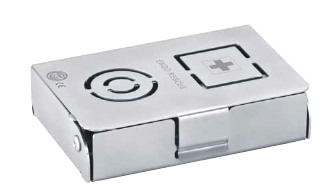How to remove instrument fragments with Komet® Endo Rescue Kit [VIDEO]
In this how-to video, learn how to extract fractured instrument fragments with Komet USA's Endo Rescue Kit 4601.
In this how-to video, learn how to extract fractured instrument fragments with Komet USA's Endo Rescue Kit 4601.
Frequently caused by incorrect or insufficient preparation of the canal access or the access cavity, instrument fracture during endodontic treatment increases the risk of post-endodontic complications for the patient and can cause enormous stress for the dentist. Removing the fractured instrument fragments is often extremely difficult and almost impossible to plan.
The Komet® Endo Rescue Kit (No. 4601) offers a simple, systematic solution to the problem, provides access to the opening of the root canal, and allows the removal of fractured rotary NiTi instruments.
The first step in the fragment-retrieval sequence is proper, precise re-preparation of the access using conventional instrumentation. For this important initial step, the Komet® endodontic bur in size XXL and with a safe-tip is designed to improve visibility while reshaping the access cavity.
Once the canal opening is relocated and access to the head of the instrument fragment is created, two specially developed instruments simplify subsequent steps in the procedure: (1) a center drill excavates the last few millimeters, permitting access to the fragment; and (2) an exceptionally fine trepan bur is placed onto the fragment, seizes it, and holds it in place by the dentin residues. The fragment then is pulled from the root in a rotary motion.
Clinical Sequence
1. The initial situation in which a fragment of a fractured instrument is located in the mesial root is displayed.
2. Use the endodontic bur (H269GK.315.016) to reshape the access cavity. The bur is operated at an optimal speed of 100,000 rpm.
3. With axial movements to create direct access to the fragment, employ the first short, stainless-steel Gates-Glidden reamer (G180A.204.110) in the kit at a speed of 800 rpm to straighten the coronal curvature.
4. Using the second Gates-Glidden reamer (G180.204.090), continue preparation of the access completely down to the fragment.
5. With the Endo Rescue center drill (RKP.204.090) operated at 300 rpm, drill around the fragment to expose the fractured surface.
6. Surround and seize the fractured fragment employing the Endo Rescue trepan bur (RKT.204.090), which should be operated at a speed of 300 rpm in counter-clockwise rotation. Firmly held by dentin residue in the trepan bur, the fragment can be safely removed.
7. The last third of the canal now can be correctly and completely prepared.
8. The final outcome following filling is shown.

The Komet® Endo Rescue Kit (4601)includes the H269GK.315.016 endodontic bur, the Gates-Glidden reamers (G180A.204.110 and G180.204.090), the center drill (RKP.204.090), the trepan bur (RKT.204.090), and a manual screw (150.155.000) for those who prefer to remove the fragments without using a handpiece. The instruments are organized and secured in a sterilizable instrument holder specially marked to indicate emergency use.